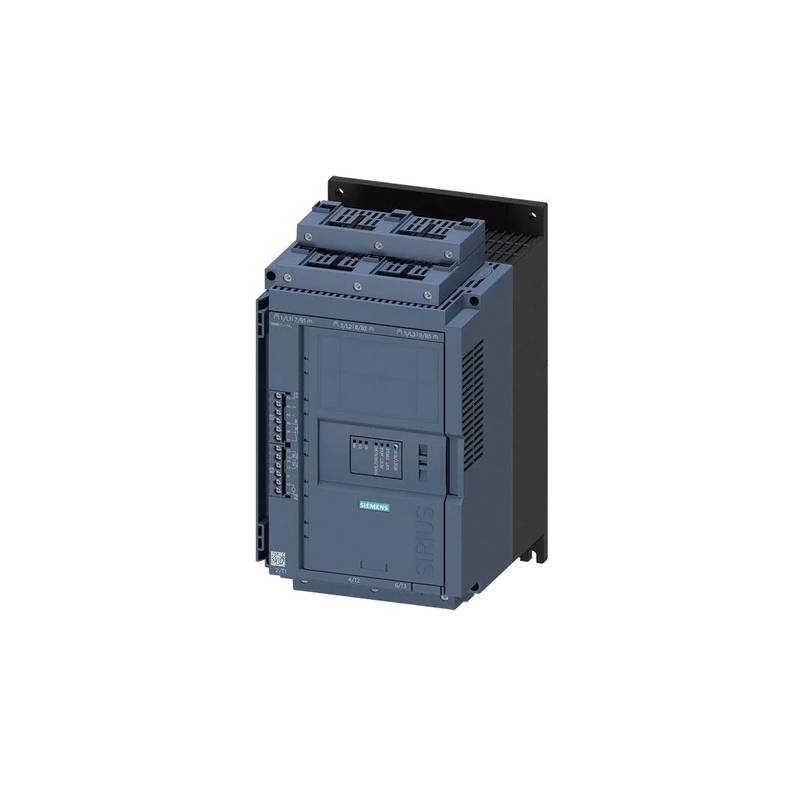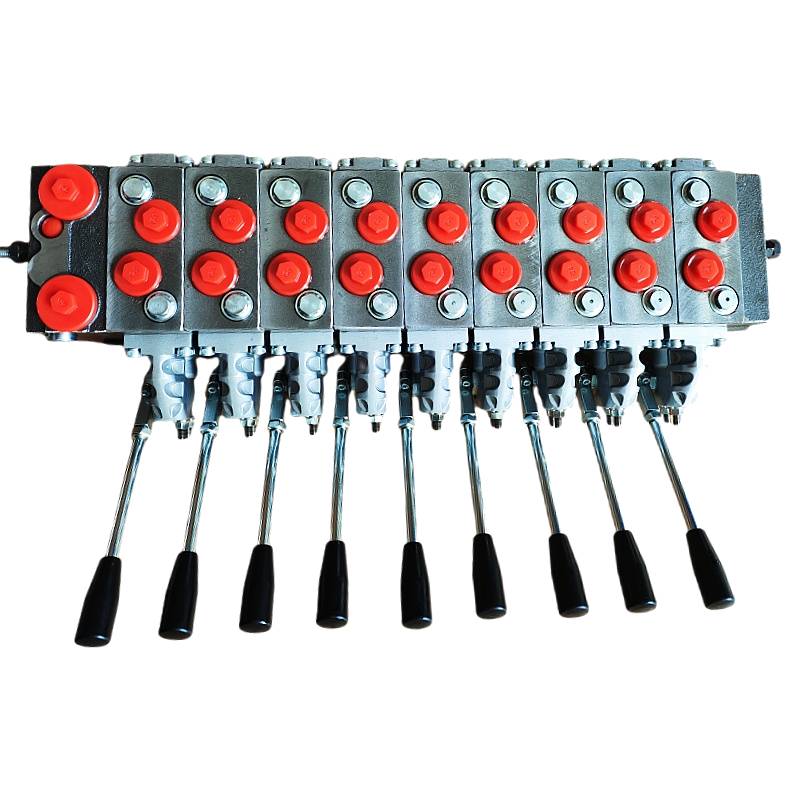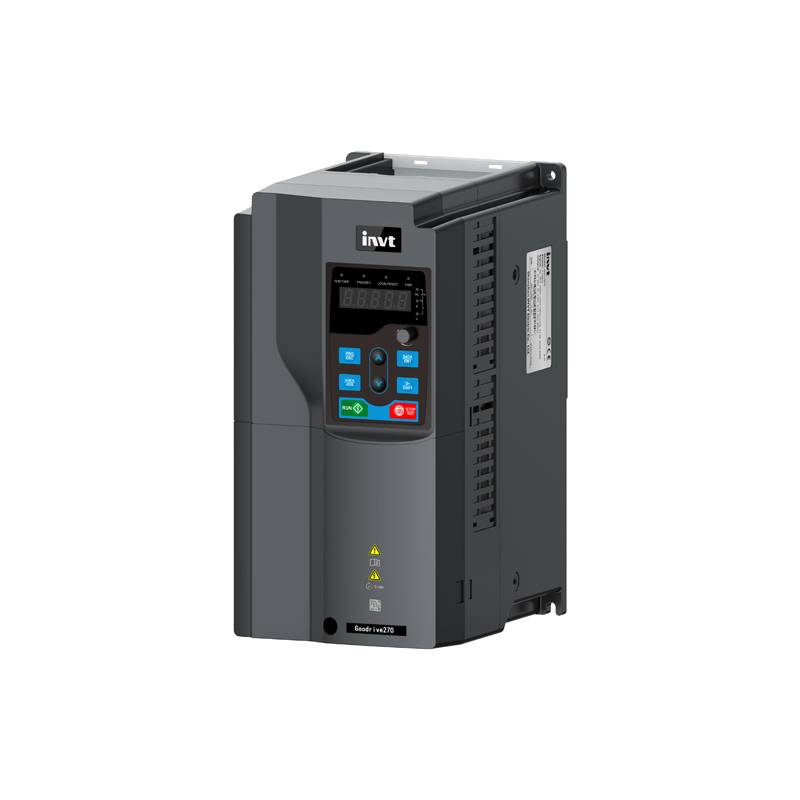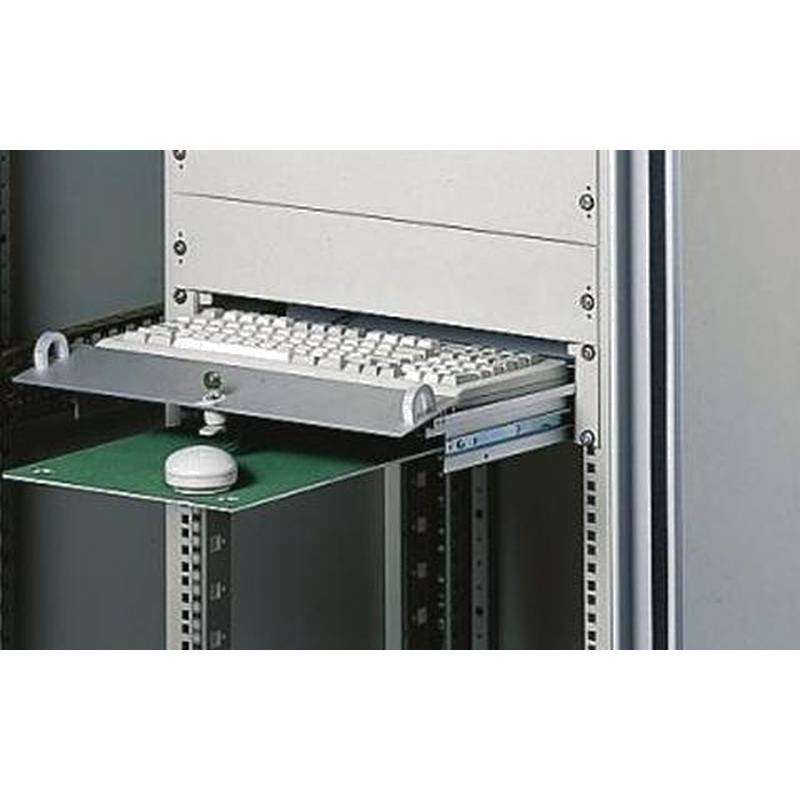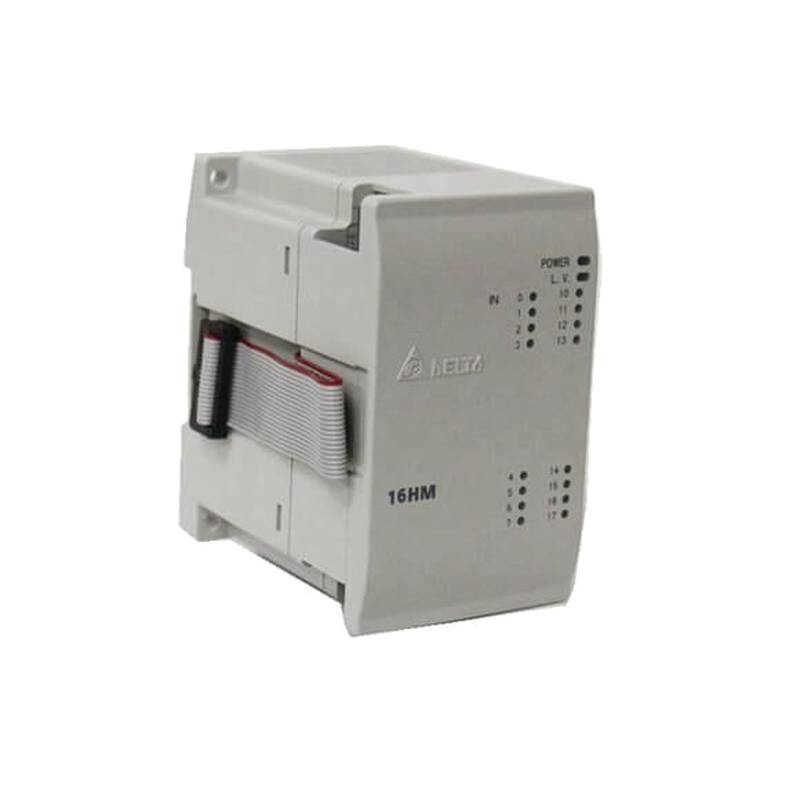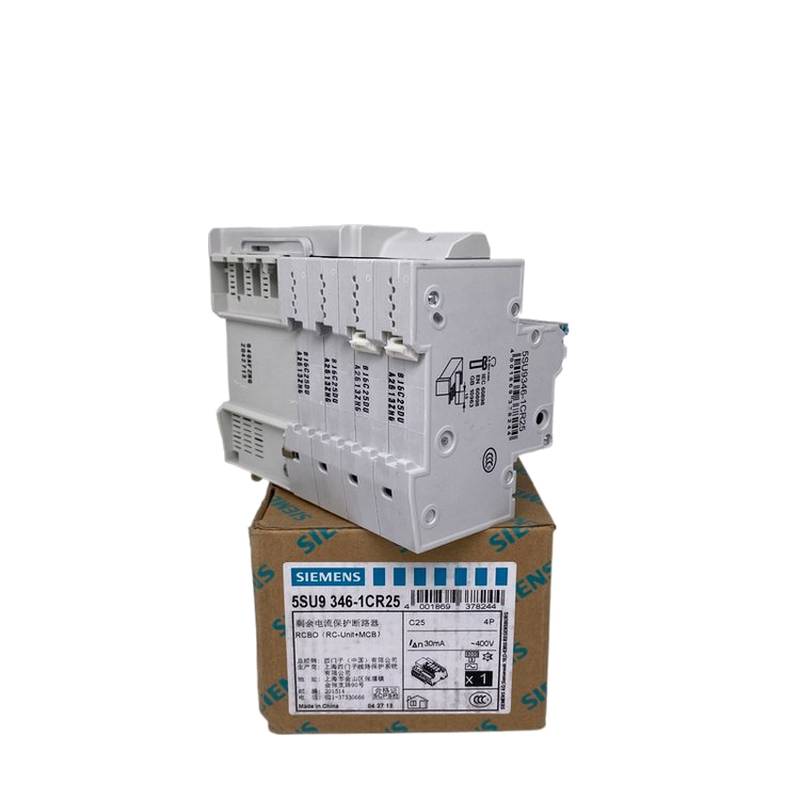
The Siemens 3RW5134-1XC14 High Power Motor Starting Protection System offers robust and efficient motor control for demanding industrial applications. This advanced soft starter excels in reducing mechanical stress during startup, prolonging equipment life, and minimizing electrical inrush current. Key advantages include its integrated bypass, advanced diagnostics, and flexible parameterization, ensuring optimal performance and operational reliability. With a rated operational current of 113A and a motor power rating of 55kW at 400V, the 3RW5134-1XC14 is engineered for high-power motor starting protection.
Product Specifications
| Parameter | Value |
| :------------------------ | :---------------------------------- |
| Product Type | Soft Starter |
| Rated Operational Current | 113 A |
| Motor Power (400V) | 55 kW |
| Rated Voltage | 200-480 V AC |
| Control Voltage | 24 V DC |
| Integrated Bypass | Yes |
| Communication Interface | Modbus RTU |
| Dimensions (H x W x D) | 266 mm x 140 mm x 225 mm |
| Protection Class | IP20 (with enclosure) |
| Temperature Range | -25 to +60 °C |
| Mounting Type | Rail or screw mounting |
Core Features & Market Positioning
The Siemens 3RW5134-1XC14 stands out in the market due to its fully integrated bypass functionality, which significantly reduces energy losses during continuous operation and minimizes heat generation within the control cabinet. This feature directly translates to lower operating costs and enhanced system reliability. Its sophisticated motor protection algorithms, including thermal overload and phase imbalance detection, provide comprehensive safeguarding against common motor failures. The device's advanced diagnostics capabilities, accessible via an integrated display and communication interfaces like Modbus RTU, empower operators with real-time insights into motor performance and system status, facilitating predictive maintenance and minimizing downtime. This combination of efficiency, protection, and data accessibility positions the 3RW5134-1XC14 as a premium solution for critical industrial motor control.
Key Application Scenarios
This high-power motor starting protection system is ideally suited for a wide array of demanding industrial applications where reliable and controlled motor startup is paramount. Its robust design and advanced features make it an excellent choice for driving large pumps in water treatment plants, conveyors in material handling systems, and compressors in manufacturing facilities. The Siemens 3RW5134-1XC14 is particularly beneficial in sectors such as mining, oil and gas, and heavy manufacturing, where equipment subjected to high starting torques requires precise control to prevent mechanical damage and ensure smooth operation. Furthermore, its application in fan systems for HVAC in large commercial buildings contributes to energy savings and reduced noise pollution during startup.
Practical System Integration Guidance
Integrating the Siemens 3RW5134-1XC14 into existing or new control systems is streamlined due to its standard mounting options and clear terminal designations. For electrical connections, ensure the main power supply (200-480V AC) is correctly wired to the power terminals L1, L2, L3, and T1, T2, T3. The 24V DC control voltage supply should be connected to the designated terminals. Establishing communication via Modbus RTU involves connecting the A and B terminals to your master device's communication bus. Parameterization is typically performed through the device's HMI or remotely via the Modbus interface. Initial setup often involves configuring motor nominal current, ramp-up time, and desired protection thresholds based on the specific motor and application requirements. For complex installations, consulting the official Siemens documentation for detailed wiring diagrams and communication setup procedures is recommended.
Operation and Risk Mitigation
Operating the Siemens 3RW5134-1XC14 involves understanding its control interface for initiating and stopping motor sequences, as well as monitoring diagnostic information. The system automatically manages the motor's acceleration ramp, gradually increasing voltage to limit starting current and torque, thereby protecting both the motor and the driven load from mechanical shock. Risk mitigation is inherent in its design through multiple protection functions. Key safeguards include overload protection, which prevents motor burnout by monitoring current draw against set limits, and phase failure detection, which immediately halts operation if a phase is lost, preventing single-phasing damage. In the event of a fault, the system displays specific error codes on its interface, allowing for quick identification and troubleshooting. For instance, an "Overload" warning (e.g., F01) indicates the motor has been drawing excessive current, while a "Phase Failure" alarm (e.g., F04) signals an issue with the power supply. Proper installation and adherence to recommended operating parameters are critical to minimizing operational risks and ensuring the longevity of the equipment.
Scalability & Long-Term Value
The Siemens 3RW5134-1XC14 offers significant long-term value through its inherent scalability and compatibility with Siemens' broader industrial automation ecosystem. Its Modbus RTU communication capability allows seamless integration into Supervisory Control and Data Acquisition (SCADA) systems and Human Machine Interfaces (HMIs), facilitating centralized monitoring and control of multiple motor-driven processes. This connectivity is a foundational element for implementing Industrial Internet of Things (IIoT) strategies, enabling data analytics for performance optimization and predictive maintenance. While the 3RW5134-1XC14 itself is a robust, standalone solution, its integration potential means that as a facility's automation needs evolve, this soft starter can be managed and coordinated with other Siemens components, such as PLCs and variable frequency drives, within a unified platform, ensuring a future-proof investment.
Frequently Asked Questions (FAQs)
1. What are the primary benefits of using the Siemens 3RW5134-1XC14?
This soft starter significantly reduces mechanical stress during motor startup. It minimizes electrical inrush current, protecting the power grid. The integrated bypass enhances energy efficiency during operation.
Its advanced diagnostics provide real-time insights into motor health. Extended equipment lifespan and reduced maintenance costs are key advantages. The Siemens 3RW5134-1XC14 ensures reliable and controlled motor operation.
The system offers flexible parameterization for diverse applications. This leads to optimized performance and operational safety. Its robust design ensures longevity in demanding industrial environments.
2. How does the Siemens 3RW5134-1XC14 protect the motor?
The 3RW5134-1XC14 incorporates sophisticated overload protection. It monitors motor current against set thresholds to prevent overheating. This safeguards the motor windings from permanent damage.
Phase imbalance and failure detection are crucial features. The system halts operation if power supply issues arise. This prevents costly damage from single-phasing.
It also offers adjustable current limitation and thermal memory. These functions track motor temperature, ensuring protection under various load conditions. Comprehensive safeguards maximize motor lifespan.
3. What is the typical installation process for this soft starter?
Installation involves mounting the unit securely, either on a rail or using screws. Connect the main power supply (200-480V AC) to the input terminals (L1, L2, L3). Connect the motor leads to the output terminals (T1, T2, T3).
Ensure the 24V DC control voltage is properly connected. For Modbus RTU communication, link the A and B terminals to your network. Follow wiring diagrams precisely for safe and correct integration.
Initial parameterization sets motor nominal current, ramp times, and protection settings. This is done via the device's HMI or communication interface. Always refer to the user manual for detailed instructions.
4. Can the Siemens 3RW5134-1XC14 be used with different motor types?
Yes, this soft starter is designed for three-phase AC induction motors. It is suitable for a wide range of standard motor applications. The key is to correctly configure its parameters for the specific motor.
Key settings include the motor's nominal current and power rating. Adjusting ramp-up times and current limits ensures compatibility. Proper configuration is essential for optimal performance and protection.
The 3RW5134-1XC14 supports motors up to 55kW at 400V. It's crucial to match the device's capacity to the motor's requirements. Always verify compatibility before installation.
5. What communication protocols does the 3RW5134-1XC14 support?
The Siemens 3RW5134-1XC14 primarily supports Modbus RTU. This is a widely used serial communication protocol in industrial automation. It enables data exchange with PLCs and SCADA systems.
This protocol allows for remote monitoring of motor status and parameters. It also facilitates remote control of starting and stopping sequences. Configuration and diagnostics can be managed over Modbus.
Integration with higher-level control systems is straightforward. Modbus RTU ensures compatibility with many existing automation infrastructures. This enhances system flexibility and management.
6. How does the integrated bypass feature benefit users?
The integrated bypass significantly reduces energy consumption. It activates once the motor reaches full speed. During bypass, the starter essentially acts as a simple switch.
This bypass minimizes heat generation within the control cabinet. This leads to a cooler operating environment and potentially smaller enclosures. It also reduces power losses associated with the soft starter's power electronics.
Consequently, the integrated bypass contributes to lower operational costs. It also enhances the overall reliability of the motor control system. This feature is a key differentiator for demanding applications.
7. What are common fault codes and how can they be resolved?
A common fault code is "Overload" (e.g., F01), indicating excessive current draw. This may require checking motor load or ambient temperature. Adjusting overload settings might be necessary.
"Phase Failure" (e.g., F04) signifies a problem with the incoming power supply. Verify all three phases are present and balanced. Check wiring connections for tightness and integrity.
Other codes might relate to internal faults or communication errors. Consult the Siemens 3RW5134-1XC14 manual for a complete list. Proper troubleshooting often involves checking connections, settings, and external conditions.
8. What is the rated operational current and motor power?
The Siemens 3RW5134-1XC14 has a rated operational current of 113 Amperes. This defines the maximum continuous current it can handle. It dictates the size of the motor it can effectively control.
It is designed to start and protect motors with a power rating of up to 55 kilowatts at 400 Volts. This specification is crucial for matching the soft starter to the motor. Ensure your motor's power requirement is within this range.
Exceeding these limits can lead to device malfunction or failure. Always verify these ratings against your motor's nameplate data. This ensures safe and reliable operation.
9. Does this soft starter offer adjustable ramp-up and ramp-down times?
Yes, the 3RW5134-1XC14 features adjustable ramp-up times. This allows users to set how long it takes the motor to reach full speed. Shorter ramps provide faster startup, while longer ramps offer smoother acceleration.
It also provides adjustable ramp-down times. This controls the deceleration phase of the motor. Smooth ramp-down minimizes mechanical shock when stopping.
These parameters are critical for tailoring the starting and stopping characteristics. They optimize performance for specific loads, such as pumps or conveyors. Proper adjustment reduces stress on the driven equipment.
10. How does the Siemens 3RW5134-1XC14 contribute to energy savings?
The integrated bypass feature is a primary contributor to energy savings. When the motor is running at full speed, the bypass circuit engages, reducing power losses. This is more efficient than continuously passing current through the soft starter's power electronics.
By precisely controlling the voltage during startup, it minimizes energy wasted as heat. This controlled acceleration prevents excessive current spikes, which represent inefficient power usage. Reduced peak demand can also lead to lower electricity tariffs in some industrial settings.
Furthermore, by reducing mechanical stress and vibration, the system helps maintain motor efficiency over its lifespan. Prolonged optimal motor performance indirectly contributes to overall energy efficiency in the plant.














